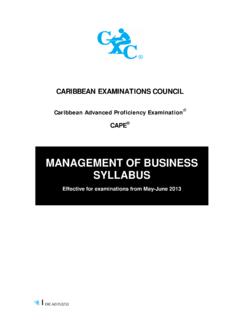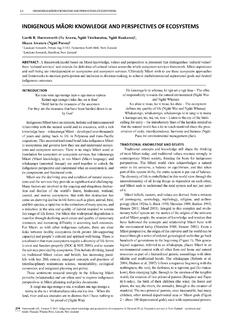Transcription of REAL ESTATE ASSET MANAGEMENT - Virginia Tech
1 real ESTATE ASSET MANAGEMENTBy Dustin Read, PhD/JDA PROCESS AND A PROFESSIONREAL ESTATE ASSET MANAGEMENTBy Dustin Read, PhD/JDA PROCESS AND A PROFESSIONii. 2017 by the Institute of real ESTATE Managementof the NATIONAL ASSOCIATION OF REALTORS . All rights report or any part thereof may not be reproduced, stored in a retrieval system, or transmitted, in any form or by any means, electronic, mechanical, photocopying, recording, or otherwise, without the prior written permission of the publisher. Inquiries should be directed to:Publishing DepartmentInstitute of real ESTATE Management430 North Michigan AvenueChicago, IL 60611 and cover composition: Nadia Geagea PupaCover image shuoshu / iStock PhotosISBN: 978-1-57203-251-4 SKU: 761 IREM logo, IREM , Certified ProPerty Manager , CPM , the CPM key logo, aCCredited residential Manager , ARM , the ARM torch logo, aCCredited MANAGEMENT organization , AMO , the AMO circle logo, Income/Expense Analysis , Expense Analysis , JPM , and MPSA are registered marks of the Institute of real ESTATE practices diversity.
2 We are an inclusive organization that embraces and values differences and welcomes individuals of all races, genders, creeds, ages, sexual orientations, gender identities, and national origins and individuals with disabilities, providing an equal opportunity environment among its members, vendors, and is dedicated to supporting real ESTATE MANAGEMENT strategies that advance an environmentally sustainable and economically prosperous of ContentsPreface ..1 Executive Summary ..3 Defining real ESTATE ASSET MANAGEMENT ..6 The Traditional real ESTATE MANAGEMENT Trichotomy ..7 Sources of Confusion and Disagreement ..10A Need for Greater Clarity and Understanding ..12 Analyzing the Perceptions of real ESTATE Executives ..14 Organizing and Interpreting the Qualitative Results ..16 Understanding ASSET MANAGEMENT as a Process.
3 18 Acquisition Support ..18 Business Planning ..21 Leading a Team ..23 Budget Preparation ..25 Approving Leases and Capital Improvements ..27 Promoting Operational Efficiency ..29 Financial Analysis ..31 Market research ..33 Disposition Assistance ..35 Surveillance and Reporting ..37 Approaches to ASSET MANAGEMENT : A Typology ..40 Analytical ASSET Managers ..41 Operational ASSET Managers ..42 Transactional ASSET Managers ..44 Comprehensive ASSET Managers ..45 The Future of ASSET MANAGEMENT ..47 Filling Knowledge Gaps and Spotting Talent ..50 Assessing the Opportunities and Challenges Presented by Careers in ASSET MANAGEMENT ..53 Firm-Level Considerations ..56 Concluding Remark ..57 References ..58 About the AuthorDustin C. Read, PhD/JD, serves as an Assistant Professor of Property MANAGEMENT and real ESTATE in the College of Liberal Arts and Human Sciences at Virginia Tech, where he teaches courses in ASSET MANAGEMENT , commercial leasing and real ESTATE development.
4 His research interests include ASSET MANAGEMENT , property MANAGEMENT and the role of real ESTATE in local economic development. Special ThanksDustin C. Read, PhD/JD, acknowledges the insights of the following individuals who served as reviewers of the publication s manuscript: Craig L. Cardwell, CPM , Principal of Island Investment Interests Lori A. Tillis, CPM , Senior ASSET Manager, Ohio Capital Corporation for Housing Olan Brevard, CPM , Senior Vice President Acquisitions and Development, the Institute of real ESTATE ManagementThe Institute of real ESTATE MANAGEMENT (IREM ) is an international community of real ESTATE managers dedicated to ethical business practices, maximizing the value of investment real ESTATE , and promoting superior MANAGEMENT through education and information sharing.
5 An affiliate of the National Association of REALTORS , IREM is the home for all industry professionals connected to real ESTATE MANAGEMENT and the only organization serving both the multi-family and commercial sectors. IREM offers a variety of membership types for professionals of every experience level, from on-site managers to high-level executives. IREM awards these credentials CPM , ARM , ACoM, and AMO to those who meet high standards of education, experience, and ethical business practices. Since 1933, IREM has set the standard for best practices in real ESTATE MANAGEMENT . Today, IREM membership includes over 19,000 individual and 550 corporate 2003, IREM published a Glossary of real ESTATE MANAGEMENT Terms describing the responsibilities of property managers and ASSET managers in the following way: These definitions still have relevance, but the property MANAGEMENT and ASSET MANAGEMENT disciplines are clearly different today than they were 10 to 20 years ago.
6 Competitive pressures have forced real ESTATE practitioners working in these closely aligned fields to expand their service offerings and collaborate closely with each other in order to achieve the investment objectives of sophisticated real ESTATE ownership groups. This type of behavior has contributed to what many call a blurring of the lines between property MANAGEMENT and ASSET MANAGEMENT functions that can make it difficult to differentiate between the two in practice. While their roles are distinct, property managers and ASSET managers share common goals. Both seek to drive value property managers, primarily through hands-on, day-to-day operational activities, and ASSET managers, by being keenly focused on the strategic and financial aspects of the investment. Frequently, these two roles funded this study to gain a better understanding of the core responsibilities of ASSET managers and the skills required for success in the profession.
7 The project is intended to complement the substantial amount of research IREM has undertaken in the past examining the evolving job requirements of both property managers and ASSET managers and the tasks they commonly perform. By focusing on the perspectives of ASSET managers and the individuals Property Manager: The person who supervises the day-to-day operation of a property, making sure it is properly leased, well maintained, competitive with other sites, and otherwise managed according to the owner s Manager: One who is charged with supervising an owner s real ESTATE assets at the investment level .. An ASSET manager may have only superficial involvement with day-to-day operations at the whom they regularly work, the research is anticipated to contribute to the existing body of knowledge and paint a clearer picture of the real ESTATE MANAGEMENT process as a whole.
8 The results are also expected to serve as a foundation for future efforts intended to enhance the profile of real ESTATE ASSET MANAGEMENT as a professional service and improve the quality of educational programs available to those who currently work in the field or aspire to do so in the future. SUMMARY1. What are the roles, responsibilities, and requirements of real ESTATE ASSET managers? 2. What education, training, and skills tend to contribute to long-run success in the industry? 3. How do real ESTATE investment companies source and develop ASSET MANAGEMENT talent? 123 Purpose: ASSET MANAGEMENT is critically important to the success of many large real ESTATE investors, yet it is often poorly understood by those working outside the field. Therefore, it is important to clarify the roles ASSET managers play in different types of organizations for a number of reasons: Defining the unique body of knowledge required for success in real ESTATE ASSET MANAGEMENT can help establish it as a professional service, providing a status that will attract talent to the industry.
9 Understanding what is expected of real ESTATE ASSET managers can help education providers better tailor their offerings to meet evolving industry needs. Differentiating real ESTATE ASSET MANAGEMENT from property MANAGEMENT in more clear and concrete terms can improve communication and understanding between these two groups. Methodology:The research presented addresses existing knowledge gaps by summarizing the results of more than 90 interviews conducted with real ESTATE practitioners familiar with ASSET MANAGEMENT as both a process and as a profession. In the aggregate, the results of the qualitative analysis offer answers to the following three questions: Major Findings: The ASSET MANAGEMENT process typically involves a series of interrelated functions or activities designed to enhance the financial performance of income-producing properties, which include (1) acquisition support, (2) business planning, (3) leading a team, (4) budget preparation, (5) lease/capital expense approval, (6) promoting operational efficiency, (7) market research , (8) financial analysis, (9) disposition assistance, and (10) reporting/surveillance.
10 SUMMARY These functions can be delegated to a number of different parties in a number of different ways depending upon the structure, culture, and strategic objectives of a given real ESTATE firm. Some individuals holding ASSET MANAGEMENT titles engage in all of these activities and have considerable autonomy to make property-level decisions. Other ASSET managers have much narrower job descriptions and far less discretion. These differences make it difficult to define ASSET MANAGEMENT as a profession in universally accepted terms. Acquisition support Business planning Leading a team Budget preparation Lease/capital expense approvalThe following interrelated functions or activities in the ASSET MANAGEMENT process are designed to enhance the financial performance of income-producing properties: Promoting operational efficiency Market research Financial analysis Disposition assistance Reporting/surveillance The interviews suggest four common approaches to ASSET MANAGEMENT exist throughout the real ESTATE industry, which are distinguishable based on the amount of attention devoted to financial MANAGEMENT relative to human resource MANAGEMENT .






